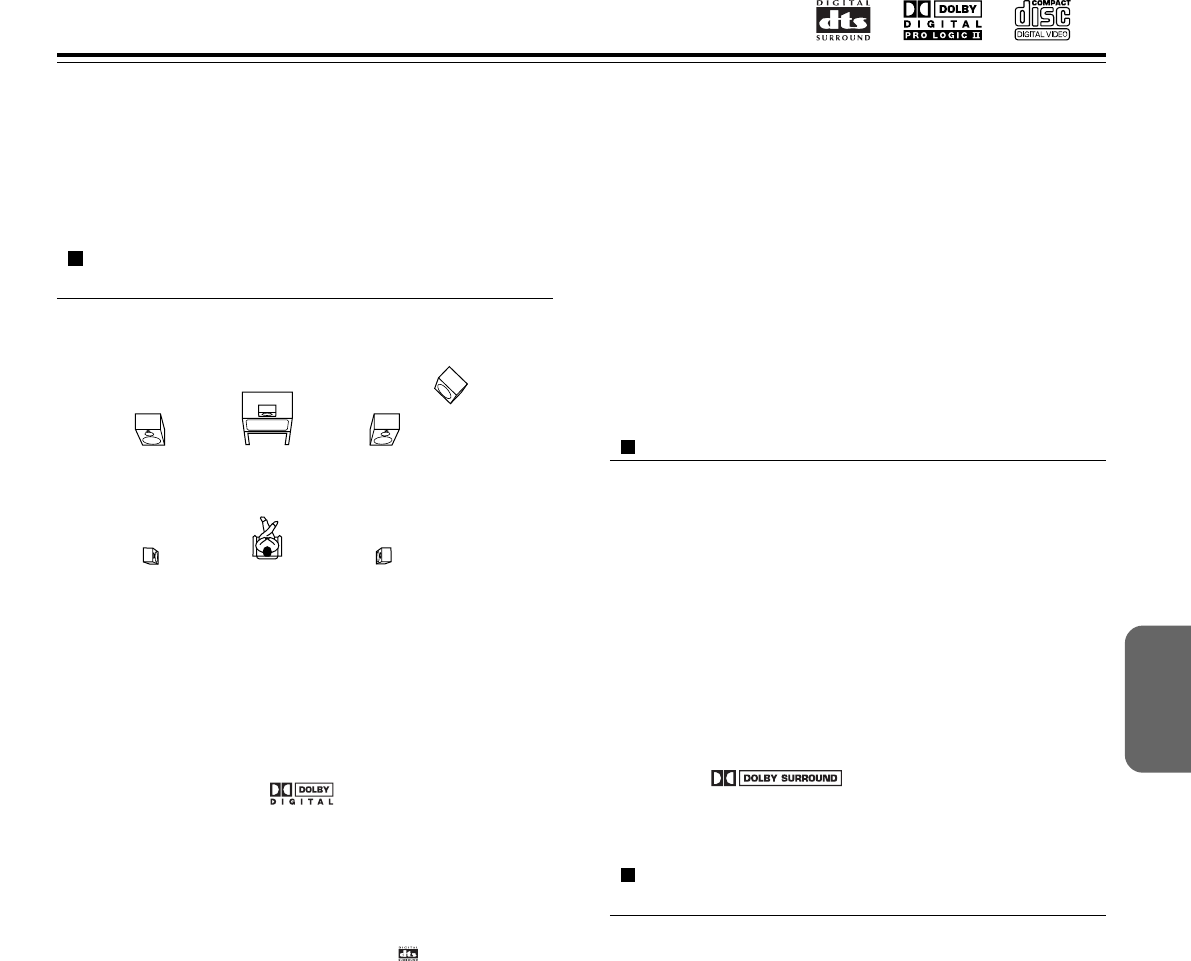
27
Enjoying the Sound Effects
The surround sound of the DVD Changer Receiver enables you to enjoy the presence of a movie theater or concert hall in your
room.
Before using any sound effect, make sure the Speaker Setup configurations have been set (see pages 24-26).
The speaker configuration is very important for the surround sound. See “Connecting Speakers” on page 16 and “Positioning
Speakers” on page 17.
Following are the sound systems the DVD Changer Receiver can reproduce.
• Some CD players (if connected to the DVD Changer Receiver)
and LD players may be unable to play DTS Surround sources
correctly even if you connect the player to the DVD Changer
Receiver digitally. In such a case, the digital signals (such as the
output level, sampling frequency, frequency response, etc.)
processed by the DVD Changer Receiver cannot be recognized as
DTS data by the DVD Changer Receiver and you may hear noise
instead of the proper sound.
DOLBY PRO LOGIC II Surround
This is a new generation 5-channel surround system,
bridging the gap between the previous 4-channel (Left/Right
Front, Center and monaural surround channels) Pro Logic
surround and 5.1-channel Dolby Digital surround. Dolby Pro
Logic II provides the Movie mode optimized for viewing
movies and the Music mode optimized for listening to music.
In the Movie mode, the surround channel, which was
monaural and based on narrow band, is reproduced in stereo
so that the feeling of movement in the played movies is more
enhanced. In the Music mode, the surround channel
reproduces natural sound field even with 2-channel music
sources.
The Movie mode allows you to enjoy VHS and DVD software
carrying the
marking as well as some of TV
broadcast programs. The Music mode allows you to enjoy
stereo music from CD, etc.
Onkyo’s original Digital Signal Processing
(DSP) modes
The DVD Changer Receiver offers the following special
Onkyo sound effects for sources other than Dolby Digital and
DTS sounds.
Orchestra
This mode is suitable for classical and opera music. The
center channel is cut and the surround channels are
emphasized to widen the stereo image. It simulates a natural
reverberation as created in a large hall.
Unplugged
This mode is suitable for acoustic instrumental sounds,
vocals, and jazz music. By emphasizing the front stereo
image, it simulates the acoustics in front of the stage.
Studio
This mode is suitable for rock and popular music. Lively
sounds with a powerful acoustic image will make you feel as
if you are in a club.
TV Logic
This mode offers the realistic acoustics of a TV program
being aired in the TV studio. It enhances the entire surround
sound and clarity of conversation.
All Ch St (All Channel Stereo)
This mode is useful for background music. The front and
surround channels will create a stereo image.
DOLBY DIGITAL Surround and DTS (Digital
Theater System) Surround
Recommended speaker setup
This 5.1 channel digital surround format enables you to
individually play five full-range (20Hz–20kHz) channels (left
and right front, center, and two surround channels) plus an
LFE (Low Frequency Effect) channel for the low-range effect
sound. It will create a realistic sound like that heard in
theaters and concert halls.
DOLBY DIGITAL Surround
DVD videos that have the mark are recorded using
this system.
To playback DOLBY DIGITAL Surround sound from
connected equipment, you must make the digital connection
in addition to the above speaker configuration.
DTS Surround
DVD videos and audio CDs that have the mark are
recorded using this system.
To playback DTS Surround sound from connected equipment
such as an LD player, you must make the digital connection
in addition to the above speaker configuration.
Notes on DTS Surround
• If you play a DTS Surround encoded disc with the DVD Changer
Receiver, or a DTS encoded disc using a digitally connected
player, you may hear a noise for a short while until the DTS
decoder of the DVD Changer Receiver recognizes the DTS
encoded signal and starts operating. This is not a malfunction.
• If you play a DTS Surround source in fast reverse or fast forward,
pause, or skip a chapter or track, noise may be heard. This is not
a malfunction.
• Even when playback of the DTS Surround source stops and the
DTS signal transmission ends, the DVD Changer Receiver
remains in DTS mode and the DTS indicator remains lit. This is to
prevent noise when you pause, fast forward, fast reverse, or skip a
chapter or track of the playback source. Therefore, if the source
switches from the DTS signal to a PCM (2 channel digital stereo)
signal immediately, the PCM signal may not be played. In such a
case, stop playback for about three seconds, then resume
playback.
Right surround
speaker
Left surround
speaker
Right front
speaker
Center
Speaker
Left front
speaker
Subwoofer


















